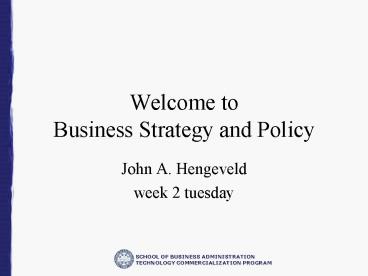Welcome to Business Strategy and Policy - PowerPoint PPT Presentation
1 / 24
Title:
Welcome to Business Strategy and Policy
Description:
Kitty Hawk Case. Core Competency Article. Innovators Solution, ch 3-5. Brown&Eisenhart ch 1-3 ... Kitty Hawk Viewed by. Brown and Eisenhart. SCHOOL OF BUSINESS ... – PowerPoint PPT presentation
Number of Views:41
Avg rating:3.0/5.0
Title: Welcome to Business Strategy and Policy
1
Welcome toBusiness Strategy and Policy
- John A. Hengeveld
- week 2 tuesday
2
AGENDA
- Kitty Hawk Case
- Core Competency Article
- Innovators Solution, ch 3-5
- BrownEisenhart ch 1-3
3
Kitty Hawk
- What went wrong with Kitty Hawk??
4
Kitty Hawk viewed by Innovators Solution
- What type of innovation was Kitty Hawk?
- What architecture?
- What type of product definition research?
5
Congruence Model Kittyhawk
Strategy
Informal Organization -TechnicalExcellence Cust
omer Needs Passion
EnvironmentResourcesHistory
Formal OutputsBalanced ScoreCardFinancial What
real expectationsshould there
be? CUSTOMER Internal How are traditional DMD
customers served? Learning and Growth What is
the learning plan for the group?
Critical Tasks -50 dumb drive Find new
markets Learn and Grow
Formal Organization Strong Resource Commitment
People Best of the best Heavyweight Team
6
The rest of DMD
Strategy
Informal Organization Strong culture of
innovation Strong culture of customer commitment
EnvironmentResourcesHistory
Formal OutputsBalanced ScoreCardFinancial CUS
TOMER Internal Learning and Growth
- Critical Tasks
- -Maintain competitive technology
- Be performance leader for HP solutions
- Keep OEM relationship strong
Formal Organization Resource AllocationIssues S
trong Sust Innov Processes
People Rest of the best Key innovatorsout
7
Technology Cycles
Product innovation
Process Innovation
Rate of Innovation
DD
DD
Substitution Event
Time
8
Types of Innovation andInnovation Streams
New
Inexpensive Mechanical Watch Smaller,
ThinnerMechanicalWatches
Swatch ContinuousAim gunfire
First Watch Quartz Watch
Markets
Existing
Incremental Small Extensionsof
Existing Technology
Architectural ReconfiguresExistingTechnology
Discontinuous New operating principles inCore
Subsystems/or DiscontinuousProcess innovation
TO, Winning Through Innovation, figure 7.3
9
Organizational CyclesThe success syndrome
SUCCESS
FIT
Inertia StructuralCultural
Size and Age
Successin StableMarkets
Failurein MarketShifts
10
How did executive team perform?
- Inc
- Culture PromotingContinuous Improvement
- Incremental Change
- Eliminate Variability
- Reward Volume Cost
- Arch
- Culture PromotingLinkage Across Units
- Adding and LinkingSubsystems
- Reward Integration
- Disc
- Culture PromotingBreakthroughs
- Many Small Failures
- Learn by Doing
- Reward Experimentationand Innovation
- Executive Team
- Provide Clear, Simple Vision
- Balance Multiple Architectures
- Makes Bets on Shifting Innovation
- Manage Ambidextrously
- Today/Tomorrow
- Large/Small Incremental/Discontinuous
11
Kitty Hawk Viewed byBrown and Eisenhart
12
Innovators Solution Key PointsCh 3-5
13
IS Ch 3
- The view of market segmentation analysis is
central to the failure of disruptive
technologies, or the vunerability to disruption
of core businesses. - Table 3-1 in the book
14
Extracting Growth from Non Consumption
- Target customers are trying to get a job done but
.. They lack a simple inexpensive solution - Customer compares disruptor with no solution at
all.. Easy performance hurdle - Deploy technology to make it foolproof
- Create a whole new value network (whole product)
15
IS F 4-3
High Commitment Rigid Plan
High Commitment Flexible Plan
Framing in the Resource Allocation Process
Opportunity Threat
Low Commitment Rigid Plan
Low Commitment Flexible Plan
Threat Opportunity
Framing in the Venture Building Process
16
IS f Ch5-1
Beat competitorswith functionality And
reliability
Interdependent Architectures, Integrated Companies
Modular Architectures, Nonintegrated companies
Range f Solutions Customers Can Utilize
Beat competitors withspeed responsiveness And
convenience
17
IS Ch 8
- Points of Executive Leverage in Strategy Making
Process - Carefully control initial cost structure
- Actively accelerate the process of finding a
viable strategy discovery driven planning - Personally drive the balancing
18
Deliberate Planning
- Make assumptions about the future
- Define a strategy based on those assumptions and
make financial projections - Make decisions to invest based on financial
projections - Implement strategy to achieve financial results.
19
Discovery Driven Planning
- Make targeted financial projections
- What assumptions must be true in order for these
projections to work? - Implement a plan to learn- test critical
assumptions and remove barriers which emerge - Invest to implement the strategy
20
BE Improvisation Survey
No Rules Many Rules Followed Ignor
ed Undefined.. Lockstep Expected Pr
oblematic Targeted. Distributed
Widely End Products.. Processes Clear
... Ambiguous Always Never Constant
Infrequent Channeled Chaotic
There are Rules are to be Processes are Change
is Responsibility is Focus is on Priorities
are .. they drive Resource Communication
is Communication is
21
BE Coadaptation
Frequent Rare Corporate LowLevel
Clear .. Undefined Team play Indivi
dual Win Common Rare
X-Business collab is .. Decisions are
made Roles of different bus The Culture
rewards Reinventing the wheel
22
BE
Five Forces CoreCompetence Game Theory Competing On the Edge
Assumptions Stable Industry Firm as bundle of competences Dynamic Oligopoly Industry inRapid change
Goal Defensible position Sustainable advantage Temporary advantage Continuous Flow of adv.
Performance Driver Industry structure Unique competencies Right Moves Ability To change
Strategy Pick Industry Pick position Shape firm Craft vision Build competencies to match Make the right Competitive Collaborative moves Gain the edge Time pace, shape semicoherent, Strat. direction
Success Profits Long Term Dominance Short Term Wins Continual Reinvention
23
BE Chapter 1
Setting the Pace -time pacing
Time Pacing
Gaining Advantagesfrom the Past-Regeneration
Winning TomorrowToday -options-learning
Edge of Time
Playing the Improvisational Edge
Capturing Cross-BusinessSynergies -Coadaptation
Edge of Chaos
24
Core Competency Article
- Frequently misquoted and mispurposed
- Why?
- What is the essential theme shown here?































